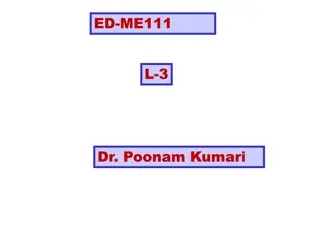Understanding Scale Factors and Ratios in Similar Figures
Explore the concept of scale factors and ratios in similar figures through visible learning intentions, warm-up exercises, and practical examples. Learn to determine the scale factor between two similar figures, use scale factors to find missing sides, and apply the knowledge in real-world scenarios
3 views • 13 slides
Understanding Isometric Projections and Drawings
Isometric projections provide a way to represent objects in three dimensions on a two-dimensional surface, making it easier for non-technical individuals to grasp complex shapes. This article discusses the differences between orthographic and pictorial views, principles of projection, types of proje
6 views • 10 slides
Importance and Types of Scale in Architecture
Scale is crucial in architecture for accurate designs and execution. Standard scales are used in architectural drawings to set object sizes, such as human scale and miniature scale. Human scale relates to human dimensions, while miniature scale reduces object sizes. Understanding these scales enhanc
1 views • 6 slides
Tips for Tackling Assembly Drawings in HSC Yr 12 Engineering Studies
When approaching assembly drawings in HSC Yr 12 Engineering Studies, start by analyzing the question and identifying key criteria. Follow AS1100 standards, focus on dimensions and notes, align components carefully, and add detail progressively. Use simple drawing tools and apply sectioning where nee
1 views • 10 slides
Step-by-Step Guide for Creating Pictorial Drawings
Learn how to create pictorial drawings step by step with detailed instructions and visuals. Follow along to sketch objects viewed from different directions such as antennas and toggle switches. Understand the importance of orientation, proportion, and scale in producing accurate and detailed drawing
0 views • 8 slides
The New Trade Theory and Economies of Scale in International Trade
The New Trade Theory, emerged in the 1970s, challenges traditional trade theories by emphasizing the role of increasing returns and economies of scale in international trade. It introduces the concept of industrial organization and imperfect competition to explain how countries trade not only based
0 views • 12 slides
Understanding Acids and Bases: pH Scale Explained
Exploring the pH scale, this content delves into the fundamentals of acidity and alkalinity, covering what pH stands for, the inventor of the pH scale, reactions when acids and bases combine, and where the weakest acids and bases are found on the pH scale.
0 views • 7 slides
Exploring Orthographic Drawing in Design and Technology Education
Delve into the world of orthographic drawing through St. Columba's Design and Technology Department's S1 Graphic Communication program. Discover the significance of orthographics in visualizing 3D objects as 2D drawings, learn about orthographic views like Elevation, Plan, and End Elevation, and exp
0 views • 8 slides
Understanding Plane Surfaces in Engineering Drawings
Exploring the concept of plane surfaces in technical drawings, this informative content covers the definition, characteristics, and positioning of planes in space relative to projection planes. It also delves into the projections of various plane surfaces parallel, perpendicular, and inclined to pri
0 views • 9 slides
Consultation on 2023/24 Fee Scale by PSAA: Key Points and Deadlines
PSAA is conducting a crucial consultation to set the fee scale for 2023/24, involving elements like audit fees, legal framework, and consultation details with stakeholders. The process includes setting scale fees, handling fee variations, adhering to statutory roles, and addressing the audit backlog
0 views • 30 slides
Urban Poor Sanitation Upgrading: Technical Design Drawings
Preparation of final design technical drawings for upscaling basic sanitation in urban poor areas. The session covers baseline data collection, existing levels, and required minimum levels for effective sanitation infrastructure. Details on drainage channels and design cross-section drawings are inc
0 views • 16 slides
Understanding Scale Factors and Similar Shapes in Graphic Design
Graphic artists often need to resize shapes for different purposes while ensuring they maintain their original proportions. This involves determining the scale factor between similar shapes, understanding how to find the scale factor using corresponding sides, and dealing with scenarios where sides
0 views • 8 slides
Understanding Horizontal Boundaries of Firms in Economics
Exploring the concept of horizontal boundaries in firm behavior, this lecture delves into Long-run Average Cost curve, economies and diseconomies of scale, optimal plant size, and the Minimum Efficient Scale. It discusses how economies of scale affect production costs and the relationship between ma
0 views • 25 slides
WMO Scale of Assessment and Working Capital Fund
The WMO Scale of Assessment for members' contributions and the Working Capital Fund is based on the United Nations Scale, adjusted for differences in membership every 3 years. The latest scale approved by EC-75 for 2023 uses the UN scale from December 2021. The rates for 2026-2027 will be determined
0 views • 9 slides
Understanding Building Drawings in Graphic Communication
Building drawings play a crucial role in the construction industry, providing detailed plans for architects, builders, plumbers, electricians, and joiners. These drawings include location plans, floor plans, sectional views, elevations, and schematic diagrams, each serving a specific purpose in the
0 views • 11 slides
Introduction to Engineering Drawing Language and Drawing Tools
Engineering Drawing Language uses lines to depict object surfaces, edges, and contours, while Freehand Drawing is sketched without instruments. Drawing Instruments ensure precise drawings to scale. Learn to draw horizontal and vertical lines, and angles using drawing tools like T-Square and triangle
0 views • 29 slides
Nature Drawing Tasks for Art Class
Complete a series of nature drawing tasks including recreating shells, creating skull drawings, experimenting with mark making techniques, and working on charcoal drawings. Reflect on your work to improve and develop your drawing skills further.
0 views • 6 slides
Urban Poor Sanitation Design Technical Drawings and Planning View
Ensuring basic sanitation for urban poor, this project involves designing and planning technical drawings with a focus on upscaling basic sanitation facilities. The content provides insight into the context of the session, potential DTF layouts, considerations during layout preparation, and baseline
0 views • 17 slides
Understanding Pressure Ulcer Risk Assessment with the Braden Scale
Pressure ulcer risk assessment is crucial in healthcare settings to identify individuals at risk of developing pressure ulcers. The Braden Scale, developed in 1984, evaluates six key elements contributing to pressure ulcer development. It provides a standardized method for assessing risk levels base
0 views • 20 slides
CAD Drafting Essentials: Commands and Tools Overview
Explore essential CAD drafting commands including BHATCH for filling areas, DIM for dimensioning, HATCHEDIT for modifying hatches, SCALE for resizing objects, and STRETCH for stretching objects. Learn about controlling dimension variables like Dimasz and Dimadec for precision in your drawings.
0 views • 11 slides
Analog Devices Product Outline Drawings Comparison
This content compares three different product outline drawings from Analog Devices, focusing on the differences in exposed paddle length and width, as well as the Pin1 indicator. It provides detailed information on the CP-8-5 and CP-8-13 packages, highlighting key specifications and dimensions. The
0 views • 4 slides
Approach of Line Vectorization in Engineering Drawings Based on Semantic Segmentation
Engineering drawings often need to be redrawn or reedited over time, leading to a high workload. To address this issue, a line segment vectorization method based on semantic segmentation is proposed. By using advanced algorithms and techniques, this approach aims to extract and vectorize line elemen
0 views • 14 slides
Blueprint Reading for High-Performance Manufacturing Technicians
Explore the world of blueprint reading in high-performance manufacturing through a hands-on course that covers multi-view drawings, individual work tasks, and online resources. Dive into sketching multi-view drawings and completing assigned labs. This course is fully funded by MoSTEMWINs and offers
0 views • 7 slides
Comparing Scale-Up vs. Scale-Out in Cloud Storage and Graph Processing Systems
In this study, the authors analyze the dilemma of scale-up versus scale-out for cloud application users. They investigate whether scale-out is always superior to scale-up, particularly focusing on systems like Hadoop. The research provides insights on pricing models, deployment guidance, and perform
0 views • 27 slides
Anupam Saxena's ME 251 Lecture III - Part and Assembly Drawings: Example II
Anupam Saxena, a professor in Mechanical Engineering at the Indian Institute of Technology Kanpur, presents a detailed study on part and assembly drawings in ME 251 Lecture III. The lecture covers examples such as non-return valves, threaded fasteners, bolts, nuts, sizes, proportions, and representa
0 views • 18 slides
Exploring Feed Check Valve Assembly in Mechanical Engineering Lab
Dive into the detailed assembly drawings of a feed check valve prepared by Professor Anupam Saxena and his team in the Mechanical Engineering Compliant and Robotic Systems Lab at the Indian Institute of Technology Kanpur. The drawings highlight various components like the body, cover, valve seat, sp
0 views • 17 slides
Remote Sensing and GIS Applications in Photogrammetry: Understanding Scale Variations
Exploring the fundamental principles of photogrammetry in remote sensing and GIS applications, this content delves into the science of measurements from aerial photographs. It discusses the implications of scale differences on maps and aerial photographs, emphasizing the variations in scale due to t
0 views • 19 slides
Understanding Engineering Assembly Drawings and Detail Requirements
Engineering assembly drawings play a crucial role in providing detailed information for the manufacture and assembly of machines and structures. Quality assurance requirements, working drawings, and detail drawing specifications are essential aspects covered in this content. Properly created assembl
0 views • 20 slides
Understanding Scales and Representative Fractions in Technical Drawings
Scales play a crucial role in technical drawings by representing the ratio of the linear dimensions of an object to its actual dimensions. This text explains the concept of scales, including enlargement and reduction scales, representative fractions (RF), recommended scales by BIS (SP.46: 2003), and
0 views • 29 slides
PrEP Scale Up in Kenya: Bridge to Scale Project Overview
PrEP Scale Up in Kenya: Bridge to Scale Project sessions in 2017 discussed the National HIV Prevalence, PrEP journey, TWG composition, milestones, sub-committees, and outputs focusing on scaling up PrEP as an effective HIV-prevention intervention.
0 views • 20 slides
Understanding ISO 10110 Optical Drawing Standards
ISO 10110 Optical Drawing Standards provide guidelines for preparing drawings of optical elements and systems, essential for interpreting optical drawings accurately. The standard includes 13 parts covering aspects such as material imperfections, surface form tolerances, and more. Compliance with IS
0 views • 17 slides
Spatial Visualization Techniques and Isometric Drawings
Explore spatial visualization concepts through activities like rotating shapes, connecting dots in isometric drawings, depicting 3D cubes, and creating coded plans for isometric views. Learn how to draw isometrically, define axes, and align paper for accurate representation. Develop skills in visual
0 views • 29 slides
Understanding Scale Drawings and Compass Points
Learn to interpret information from problems, create scale drawings, solve real-life problems using scale drawings, understand compass points, and follow directions accurately. Practice solving problems involving scale drawings, bearings, compass points, and map directions to enhance your spatial sk
0 views • 19 slides
Understanding the Difference Between Trademark Drawings and Patent Drawings
Discover the key differences between trademark and patent drawings in this detailed guide. Learn their unique purposes, essential requirements, and why accuracy matters in intellectual property applications. Whether protecting a brand's identity with
0 views • 6 slides
Understanding the Difference Between Trademark Drawings and Patent Drawings
Discover the key differences between trademark and patent drawings in this detailed guide. Learn their unique purposes, essential requirements, and why accuracy matters in intellectual property applications. Whether protecting a brand's identity with
0 views • 6 slides
Understanding the Difference Between Trademark Drawings and Patent Drawings
Discover the key differences between trademark and patent drawings in this detailed guide. Learn their unique purposes, essential requirements, and why accuracy matters in intellectual property applications. Whether protecting a brand's identity with
1 views • 6 slides
How a Patent Drawings Company Works_ Process, Services, and Benefits The Patent Experts
Learn how a patent drawings company works, the key services they offer, and how they help inventors secure intellectual property rights. Explore the process of creating accurate and compliant patent illustrations, including utility, design, and mecha
0 views • 9 slides
Scale Learning Adventures: Movie Magic and Visible Learning
Embark on a journey of scale learning through engaging activities such as Butterfly Scale Warm-up, Hobbit Holes and Hogwarts exploration, and applying knowledge at Hagrid's Shack. Discover how scale is used in real-life situations and solve problems using ratios with success criteria in mind.
0 views • 10 slides
Understanding Production Drawings and Mechanical Drawing Reading
Production drawings, also known as working drawings, provide essential information for manufacturing machines or structures. They include dimensions, material details, assembly instructions, and more. This legal document ensures manufacturing standards adherence and serves as a guide for production.
0 views • 20 slides
Overview of the Pan Tool in Design Software
The Pan tool in design software allows users to view and modify different parts of a drawing that are not on the screen. This tool can be accessed through various methods and is useful when working on large drawings. The Pan tool, along with the Aerial View window, enables users to work on specific
0 views • 6 slides







































